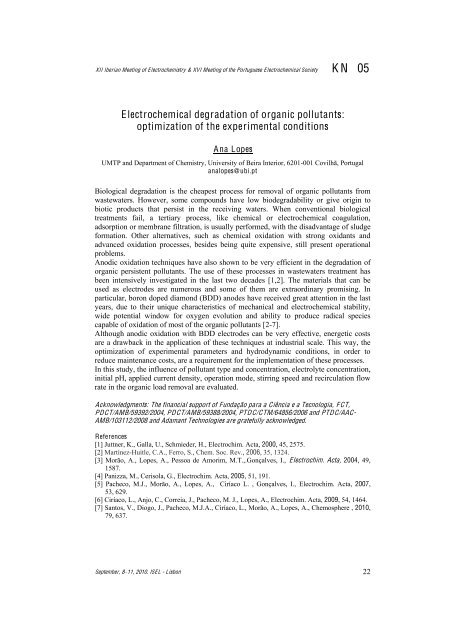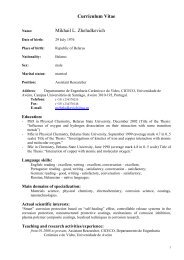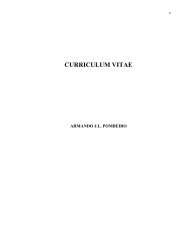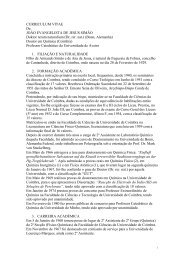XII Iberian Meeting of Electrochemistry XVI Meeting of the ...
XII Iberian Meeting of Electrochemistry XVI Meeting of the ...
XII Iberian Meeting of Electrochemistry XVI Meeting of the ...
You also want an ePaper? Increase the reach of your titles
YUMPU automatically turns print PDFs into web optimized ePapers that Google loves.
<strong>XII</strong> <strong>Iberian</strong> <strong>Meeting</strong> <strong>of</strong> <strong>Electrochemistry</strong> & <strong>XVI</strong> <strong>Meeting</strong> <strong>of</strong> <strong>the</strong> Portuguese Electrochemical Society K N 05<br />
Electrochemical degradation <strong>of</strong> organic pollutants:<br />
optimization <strong>of</strong> <strong>the</strong> experimental conditions<br />
Ana Lopes<br />
UMTP and Department <strong>of</strong> Chemistry, University <strong>of</strong> Beira Interior, 6201-001 Covilhã, Portugal<br />
analopes@ubi.pt<br />
Biological degradation is <strong>the</strong> cheapest process for removal <strong>of</strong> organic pollutants from<br />
wastewaters. However, some compounds have low biodegradability or give origin to<br />
biotic products that persist in <strong>the</strong> receiving waters. When conventional biological<br />
treatments fail, a tertiary process, like chemical or electrochemical coagulation,<br />
adsorption or membrane filtration, is usually performed, with <strong>the</strong> disadvantage <strong>of</strong> sludge<br />
formation. O<strong>the</strong>r alternatives, such as chemical oxidation with strong oxidants and<br />
advanced oxidation processes, besides being quite expensive, still present operational<br />
problems.<br />
Anodic oxidation techniques have also shown to be very efficient in <strong>the</strong> degradation <strong>of</strong><br />
organic persistent pollutants. The use <strong>of</strong> <strong>the</strong>se processes in wastewaters treatment has<br />
been intensively investigated in <strong>the</strong> last two decades [1,2]. The materials that can be<br />
used as electrodes are numerous and some <strong>of</strong> <strong>the</strong>m are extraordinary promising. In<br />
particular, boron doped diamond (BDD) anodes have received great attention in <strong>the</strong> last<br />
years, due to <strong>the</strong>ir unique characteristics <strong>of</strong> mechanical and electrochemical stability,<br />
wide potential window for oxygen evolution and ability to produce radical species<br />
capable <strong>of</strong> oxidation <strong>of</strong> most <strong>of</strong> <strong>the</strong> organic pollutants [2-7].<br />
Although anodic oxidation with BDD electrodes can be very effective, energetic costs<br />
are a drawback in <strong>the</strong> application <strong>of</strong> <strong>the</strong>se techniques at industrial scale. This way, <strong>the</strong><br />
optimization <strong>of</strong> experimental parameters and hydrodynamic conditions, in order to<br />
reduce maintenance costs, are a requirement for <strong>the</strong> implementation <strong>of</strong> <strong>the</strong>se processes.<br />
In this study, <strong>the</strong> influence <strong>of</strong> pollutant type and concentration, electrolyte concentration,<br />
initial pH, applied current density, operation mode, stirring speed and recirculation flow<br />
rate in <strong>the</strong> organic load removal are evaluated.<br />
Acknowledgments: The financial support <strong>of</strong> Fundação para a Ciência e a Tecnologia, F CT,<br />
PDCT/AMB/59392/2004, PDCT/AMB/59388/2004, PTDC/CTM/64856/2006 and PTDC/AAC-<br />
AMB/103112/2008 and Adamant Technologies are gratefully acknowledged.<br />
References<br />
[1] Juttner, K., Galla, U., Schmieder, H., Electrochim. Acta, 2000, 45, 2575.<br />
[2] Martínez-Huitle, C.A., Ferro, S., Chem. Soc. Rev., 2006, 35, 1324.<br />
[3] Morão, A., Lopes, A., Pessoa de Amorim, M.T.,.Gonçalves, I., Electrochim. Acta, 2004, 49,<br />
1587.<br />
[4] Panizza, M., Cerisola, G., Electrochim. Acta, 2005, 51, 191.<br />
[5] Pacheco, M.J., Morão, A., Lopes, A., Ciríaco L. , Gonçalves, I., Electrochim. Acta, 2007,<br />
53, 629.<br />
[6] Ciríaco, L., Anjo, C., Correia, J., Pacheco, M. J., Lopes, A., Electrochim. Acta, 2009, 54, 1464.<br />
[7] Santos, V., Diogo, J., Pacheco, M.J.A., Ciríaco, L., Morão, A., Lopes, A., Chemosphere , 2010,<br />
79, 637.<br />
September, 811, 2010. ISEL - Lisbon 22








